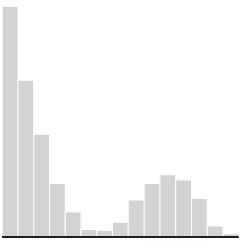Ages of the People We Marry
In our earlier years, we tend to date and marry others who are around our age. However, this is not true for everyone. Variation kicks in when you look at the later years, consider multiple marriages, divorce, separation, and opposite-sex versus same-sex relationships.
Check the following interactive chart to see how the age distributions break down, among partners who live together.
Marrying Younger and Older
Select your relationship status through the menus.
This is based on data from the five-year American Community Survey from 2022.
In the teens and early twenties, we seem to favor people closer to our own age, but then the age distribution spreads out after that. Get into the late years, and the distributions skews younger, largely because there are fewer people who are older than you as you get older.
It’s interesting to see the ages spread out more when you look at those who are divorced (and in a new unmarried relationship) or have multiple marriages.
Shift to same-sex relationships. The distributions spread out more and you see greater variation when you subset to multiple marriages. Same-sex marriage was not legalized nationally in the United States until 2015.
My main takeaway is that things appear predictable in the younger years, in first marriages, and in the population overall. But after that, as the distribution squishes down and spreads out, age grows less important.
Notes
The estimates are based on data from the five-year American Community Survey 2018-2022, which I downloaded via IPUMS. I looked at households with married couples or people in relationships who live together. This doesn’t include people who are in relationships who do not live together.
Analysis and data preparation was done in R. The rest was made with JavaScript using D3.js.
Become a member. Support an independent site. Make great charts.
See What You GetFlowingData is made possible by supporting members. Since 2007, I, Nathan Yau, a real person, have been analyzing and visualizing data to help more people understand and appreciate it in their everyday lives.
If you liked this or want to make similar data things, please consider supporting this small corner of the internet. You get unlimited access to visualization courses, tutorials, and extra resources. Thanks. — Nathan


